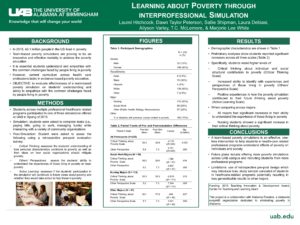#APM16 Day 2 – Learning about Poverty through Interprofessional Simulations
 Today I am presenting a poster with Allyson Varley, PhD Student in the UAB School of Public Health and a research/teaching assistant extraordinaire. Our work focuses on why and how we started implementing poverty simulations with students from diverse majors and professional programs across our campus. Poverty simulations are increasingly common in higher education, offering an innovative modality to increase students’ understanding of poverty. The simulation enables participants to view poverty from different angles in an experiential setting. The poster will cover implementation of poverty simulations and present preliminary findings on the learning outcomes for students. Other member of our working group were not able to join us at #APM16, Drs. Dawn Talyor Peterson, Sallie Shipman, Laura Debiasi and Marjorie Lee White.
Today I am presenting a poster with Allyson Varley, PhD Student in the UAB School of Public Health and a research/teaching assistant extraordinaire. Our work focuses on why and how we started implementing poverty simulations with students from diverse majors and professional programs across our campus. Poverty simulations are increasingly common in higher education, offering an innovative modality to increase students’ understanding of poverty. The simulation enables participants to view poverty from different angles in an experiential setting. The poster will cover implementation of poverty simulations and present preliminary findings on the learning outcomes for students. Other member of our working group were not able to join us at #APM16, Drs. Dawn Talyor Peterson, Sallie Shipman, Laura Debiasi and Marjorie Lee White.
Poverty simulations are increasingly common in higher education, offering an innovative modality to increase students’ understanding of poverty. The simulation enables participants to view poverty from different angles in an experiential setting. The poster will cover implementation of poverty simulations and present preliminary findings on the learning outcomes for students.
Participants who visit our poster presentation will: 1) learn the basic mechanics of a poverty simulation and how it is an effect tool of engaged learning for economic justice; 2) determine how educators can duplicate the planning process for a poverty simulation at their own institutions; and 3) appreciate the role of professional collaboration in the planning and development of service-learning projects across a curriculum.
Here is our abstract:
In 2014, 46.7 million people, or 14.8% of the US population lived in poverty (DeNavas-Walt & Proctor, 2015). Social work, nursing, and other health and human service students at will provide services to people living in poverty, both in school and in the workforce. Therefore, it is essential that students understand and empathize with the common challenges faced by people living in poverty. Team-based poverty simulations are becoming increasingly more common in higher education and are proving to be an innovative and effective modality to address the poverty education, especially in areas of social work, nursing and human services.
The most common poverty simulation is the Community Action Poverty Simulation (CAPS), created by the Missouri Association for Community Action (Missouri Community Action Network, 2016). During a simulation, participants are placed into teams of families where they seek to provide food, shelter and other basic necessities during the simulation while interacting with various community resources staffed by low-income volunteers. The poverty simulation enables participants to view poverty from different angles in an experiential, team-based setting. The literature shows that the CAPS poverty simulations are a well-received valid learning tool for increasing awareness and understanding of the complexities of poverty (Patterson & Hulton, 2011; Vandsburger et al., 2010). Students who complete a poverty simulation report increased sensitivity to and awareness of the problems for people living in poverty and state that they are more likely to engage in social action to address poverty in their communities (Patterson & Hulton, 2011; Vandsburger et al., 2010).
As part of this poster presentation, we will explain how the simulation works at our institution and discuss with participants how this learning experience could be incorporated into their curriculum. The presenters will share their experiences in executing the simulation, and assessing students learning outcomes with reflection essays and pre-post surveys. For the evaluation, we used a retrospective pre-post design survey. Using three validated scales previously used in similar research at other intuitions (Critical Thinking, Others’ Perspective and Active Learning scales), students were asked to recall how they felt about poverty before and after the simulation. Preliminary data analyses from the surveys show that students who attended the simulation reported significant changes in their thinking and views about poverty. These data suggest that team-based poverty simulations provide an effective, one-time intervention to help students in health-care related professional programs understand the effects of poverty on individuals and society. Future plans include offering more poverty simulations across the UAB campus and recruiting students from more professional programs. Lesson learned from the project will be shared and implications for poverty education will also be reviewed.
References:
DeNavas-Walt, C. & Proctor, B.D. (2015). U.S. Census Bureau, Current Population Reports, P60-252,Income and Poverty in the United States: 2014. U.S. Government Printing Office, Washington, DC.
Missouri Community Action Network. (2016). Poverty Simulations. Retrieved from http://www.povertysimulation.net/about/
Patterson, N., & Hulton, L. J. (2012). Enhancing Nursing Students’ Understanding of Poverty Through Simulation. Public Health Nursing, 29(2), 143–151.
Vandsburger, E., Duncan-Daston, R., Akerson, E., & Dillon, T. (2010). The Effects of Poverty Simulation, an Experiential Learning Modality, on Students’ Understanding of Life in Poverty. Journal of Teaching in Social Work, 30(3), 300–316.
How to Cite this post:
Hitchcock, L., Varley, A., Petersen, D.T., Debiasi, L., Shipman, S., & White, M. L. (2016, November 4). #APM16 Day 2 – Learning about Poverty through Interprofessional Simulations [Blog post]. Retrieved from https://laureliversonhitchcock.org/2016/11/04/apm16-day-2-learning-about-poverty-through-interprofessional-simulations/


